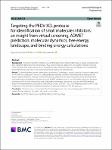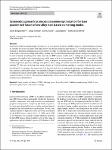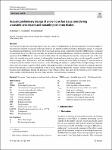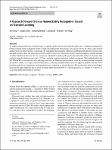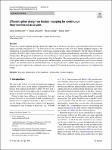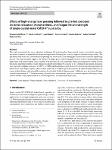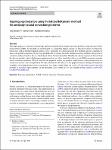Search
Author
- Amir, Ebrahimi (2)
- Aydin, Azizi (2)
- George, Haller (2)
- James, M. Fiore (2)
- next >
Subject
- robotics (9)
- Engineering (8)
- engineering (8)
- công nghệ (3)
- next >
Date issued
- 2020 - 2023 (215)
- 2010 - 2019 (28)
- 2001 - 2009 (6)
Has File(s)
- true (249)
Search Results
The porcine epidemic diarrhea virus (PEDV) represents a major health issue for piglets worldwide and does significant damage to the pork industry. Thus, new therapeutic approaches are urgently needed to manage PEDV infections. Due to the current lack of a reliable remedy, this present study aims to identify novel compounds that inhibit the 3CL protease of the virus involved in replication and pathogenesis. |
In the metal additive manufacturing (AM) process of laser powder bed fusion (LPBF), there are a limited number of materials suitable for producing parts with high density and desired mechanical properties. To establish novel materials, it is essential to determine optimized process parameters in order to overcome process-related challenges and mitigate defects such as lack of fusion, keyholing, and balling. Scaling laws based on thermophysical properties and process parameters can be used to transfer knowledge from other materials or LPBF systems. In this work, a scaling law is used to adjust process parameters for single-track experiments over a wide range, which are laser power PL (100–1000 W), scan speed vs (300–2500 mm/s), and laser spot size ds (0.08–0.25 mm). |
A low-noise low-pressure ultra-high-bypass-ratio fan stage to be implemented in the next generation of aircraft engines is described and evaluated acoustically with semi-empirical and analytical methods suited for preliminary design. As expected, good reduction potentials are observed for the jet noise and fan tonal noise components when the UHBR design is compared to current fans in service. However, concerns are identified for fan broadband noise, which are attributed to the off-design operation of the UHBR fan too close from its stability limit. By unloading the fan and thus reducing the size of the rotor wakes, the variable-area nozzle provides a substantial fan broadband noise reduction with a nozzle opened by around 15% from its design value. |
To improve the performance of named entity recognition in the lack of well-annotated entity data, a transfer learning-based Chinese named entity recognition model is proposed in this paper. The specific tasks are as follows: (1) first/, a data transfer method based on entity features is proposed. By calculating the similarity of feature distribution between low resource data and high resource data, the most representative entity features are selected for feature transfer mapping, and the distance of entity distribution between the two domains is calculated to make up the gap between the data of the two domains then model is trained by high resource data. (2) Then, an entity boundary detection method is proposed. |
We present a feature-mapping topology optimization approach, in which curved features are parametrized as piecewise linear splines smoothly rounded by arcs. The motivation for our contribution to the tool set of feature-mapping methods is the optimization of structures manufactured by variable angle continuous fiber-reinforced filaments. For this reason, the feature’s geometry should be able to represent long, curved fiber objects satisfying manufacturing constraints, such as minimum turning radius. The proposed model has been chosen with special care for rigorous continuous differentiability, as well as an efficient analytical evaluation of the signed distance field to the spline. |
Fracture of materials with rate-dependent mechanical behaviour, e.g. polymers, is a highly complex process. For an adequate modelling, the coupling between rate-dependent stiffness, dissipative mechanisms present in the bulk material and crack driving force has to be accounted for in an appropriate manner. In addition, the resistance against crack propagation can depend on rate of deformation. In this contribution, an energetic phase-field model of rate-dependent fracture at finite deformation is presented. For the deformation of the bulk material, a formulation of finite viscoelasticity is adopted with strain energy densities of Ogden type assumed. The unified formulation allows to study different expressions for the fracture driving force. Furthermore, a possibly rate-dependent to... |
This study investigated the stress relaxation and fatigue life and strength of laser-peened single-crystal nickel superalloy specimens compared to unpeened and shot-peened specimens following hot corrosion exposure and then fatigue testing. The specimens were treated by conventional laser peening and a new cyclic laser peening plus thermal microstructure engineering process. The latter treatment supports the benefit of a unique process involving application of layers of laser peening using high energy with large footprint spots combined with interspersed cyclic annealing. Stress measurements by slitting showed the plastic penetration depth of laser peening exceeded shot peening by a factor of 24. |
A cost model for the estimation of production costs of permanent magnet synchronous machines (PMSM) is presented, which allows to alter design choices such as wire technology, winding layout, cooling system, materials and more. With the goal to make results reproducible by others, the methods are explained in detail and used data and assumptions are given. The developed model helps to understand the interaction between the design of PMSM, manufacturing methods and the resulting costs. With it, different PMSM technologies and materials can be evaluated regarding its influence on the production costs, which is a perquisite to find the best compromise between performance and costs. Production volume is shown to be the most decisive factor for the resulting production costs. |
This paper proposes a density-based topology optimization method for natural convection problems using the lattice Boltzmann method (LBM). As the LBM can be developed as a completely explicit scheme, its attractive features over the traditional ones, such as the finite element method, are (1) suitability for solving unsteady flow problems and (2) scalability for large-scale parallel computing. We develop an LBM code for solving unsteady natural convection problems and provide its sensitivity analysis based on the so-called adjoint lattice Boltzmann method. Notably, the adjoint equation is derived from the discrete particle velocity Boltzmann equation and can be solved similarly to the original LBM concerning unsteady natural convection problems. |
Kaolinite is a widely available and inexpensive substance that has been successfully employed to decontaminate different hazardous contaminants from wastewater by adsorption. In this study, halloysite-like nanotubes (HNTs) were prepared via intercalation followed by ultrasonic rolling of the kaolinite layers. Then, maghemite nanoparticles were co-precipitated within the HNTs matrix to produce a maghemite/HNTs nanocomposite (MG@HNTs). XRD, SEM, TEM, FTIR, and a BET analyzer were used to characterize the MG@HNTs nanocomposite, which was then utilized to eliminate Cd(II) from aqueous solutions (water and wastewater). Using a batch methodology, the impact of various adsorption parameters on Cd(II) removal was explored. MG@HNTs nanocomposite exhibited a high adsorption capacity (qe) of 2... |

